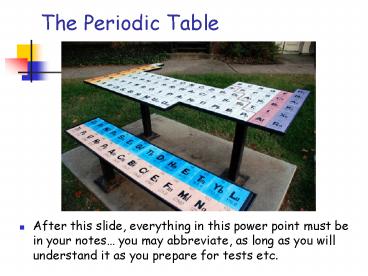The Periodic Table - PowerPoint PPT Presentation
1 / 21
Title:
The Periodic Table
Description:
The Periodic Table After this , everything in this power point must be in your notes you may abbreviate, as long as you will understand it as you prepare for ... – PowerPoint PPT presentation
Number of Views:9
Avg rating:3.0/5.0
Title: The Periodic Table
1
The Periodic Table
- After this slide, everything in this power point
must be in your notes you may abbreviate, as
long as you will understand it as you prepare for
tests etc.
2
Organization of the Periodic Table
3
1. Overview of organization
- a) Groups/ Families
- i) Go up and down
- ii) Similar chemical and physical properties
- b) Periods
- i) Rows, go across
- ii) These elements follow a repeating
pattern as you go across. - c) Classes of elements
- i) Metals-
- ii) Nonmetals-
- Iii) Metalloids-
4
2. Every element is unique!
- a) Symbol
- i) First letter must always be in
capitols! (When there are 2 letters in the symbol
the second is always in lower case!) - b) Atomic Number
- i) Tells the number of protons in the
nucleus - ii) This number is unique to every element!
- c) There are 92 (94) naturally occurring
elements! Everything beyond that is created in a
lab! (And not stable!...radioactive!)
5
3. Electron configuration
- a) Stable elements have full outer shell
(only one group is stable) That would be 8
electrons total in that outer shell - b) Because, all but the noble gases do not have
a full shell, most elements will gain or lose
their valence electrons in reactions as they form
compounds! - c) Valence electrons are the electrons in the
outer energy level.
6
II) Grouping the Elements!
7
1. Alkali Metals -Red
- a) Group 1
- b) Very reactive- will often burn or give
off gas when touched with water! - c) One valence electron! Easily give away
one electron. (This is why they are so reactive!) - d) Low density- all will float in water!
- http//video.google.com/videoplay?docid-310361068
7149839311
8
2. Alkaline Earth Metals -Orange
- a) Group 2
- b) Very reactive, but less reactive than
group 1 - c) Two valence electrons (Will lose the 2
valence electrons) - d) More dense than group 1
- http//www.youtube.com/watch?vwqErrNvns4o
9
3. Transition Metals Blue
- a) Groups 3-12
- b) Less reactive than group 2
- c) 1 or 2 valence electrons (will lose
valence electrons) - d) Higher densities and melting points than
groups 1 2 - e) Lanthanides Actinides
- i) These are part of periods 6 7
- ii) They are separated out in order to keep the
periodic table from getting too wide!
10
A look _at_ the PT w/o the La AC below!
11
4. Boron Group Yellow
- a) Group 13
- b) 3 valence electrons
- loses the outer 3 electrons
- Charge 3
- c) Reactive, because there is not a full outer
shell they will bond with other elements, but
they do not react violently!
12
5. Carbon Group White
- a) Group 14
- b) 4 valence electrons. They will either
gain or lose 4 electrons. - c) Reactivity depends on the element.
- d) Carbon is the one element that all living
things have in their atomic structure. We are
able to date very old, once living things, by
using radio carbon dating!
13
Carbon in action
14
6. Nitrogen Group Gray
- a) Group 15
- b) 5 valence electrons
- gain 3 electrons
- Charge of -3
- c) More reactive than Group 14
- d) Nitrogen makes up about 80 of the air that
you breath!
15
7. Oxygen Group Brown
- a) Group 16
- b) 6 valence electrons
- gain 2 electrons
- a charge of -2
- c) Reactive elements
- d) All but oxygen are solid at room
temperature.
16
8. Halogens Green
- a) Group 17
- b) 7 valence electrons
- gain 1 electron
- a charge of -1
- c) Very reactive! Easily combine with metals
to form compounds.
17
9. Noble Gases Purple
- a) Group 18
- b) 8 valence electrons
- except for He that has 2!
- c) Not reactive at all!
- d) Do not gain or lose electrons!
- e) Full outer shell.
18
What is going on with the attraction?
19
Homework!
- Color code your white periodic table (as per the
colors in the notes!) and put down important
information - Name of the group
- and a few facts
- reactivity the number of valance electrons!
20
Other things to include
- How to determine the number of
- Protons
- Neutrons
- Electrons
- Simple definitions
- Ions
- Isotopes
- Leave room for more stuff we are nowhere near
the end of Chemistry!
21
(No Transcript)































